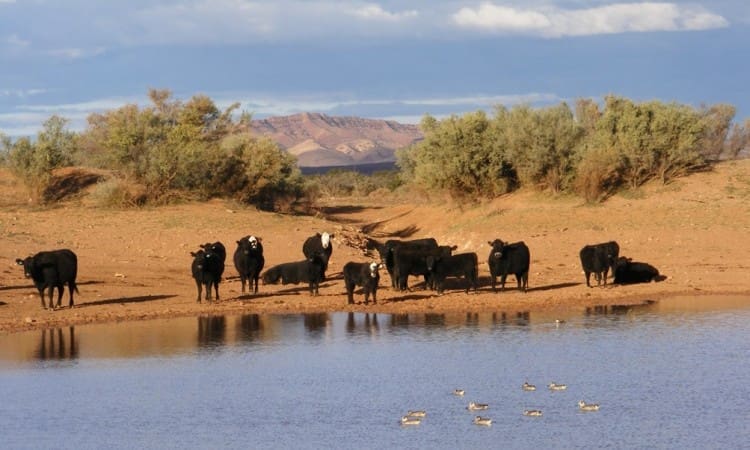
This week’s property review looks at what is in store for the remainder of the 2023 grazing property market cycle, in the opinion of two prominent valuers.
Stephen Cameron is the national director of valuation and advisory services at Colliers Agribusiness.
Mr Cameron said the property market is currently finding its feet.
“There is more risk in the market today compared to six or 12 months ago, especially for grazing assets,” he said.
“An increasing number of listings is the norm for this time of year, but the key factor on how values will be determined is the depth in the market which is ultimately underpinned by confidence.”

Stephen Cameron
Mr Cameron said the recent rain in parts of eastern and southern Australia may have given livestock producers some positive hope, together with providing a rally in the Eastern Young Cattle Indicator.
“Continued hot and dry summer weather might prompt producers to reduce numbers again and without active re-stockers participating, there is a risk of weakening commodity prices.”
Mr Cameron said there may be a reluctance to supplementary feed cattle due to the current low livestock price, and high hay and grain prices.
“Some market sectors are also experiencing pain because of financing stock debt at the higher value, compared to what they are worth today.”
“As a result, these producers are reshuffling their business finance to manage that stock debt by bringing it back into their mainstream funding, which has been assisted by equity growth in the property asset.”
He said from a real estate valuation point of view, there were some obvious risks in the current grazing property market.
“Transactions are still occurring despite cattle and sheep prices taking a downward trend for almost 12 months. For traditional assets there is still particularly strong appetite from near neighbours seeking further scale, where strong values are being reflected.”
Mr Cameron said the broader market is still recognising the opportunity to secure adjoining assets at a premium.
“It is created by the emotional decision that neighbouring properties might only come up once in a generation, hence neighbours are willing to pay overs to secure the asset.”
“In a large percentage of cases, these transactions have been negotiated over the fence, ‘off-market’, usually due to long standing gentlemen’s agreements to have first right of refusal,” Mr Cameron said.
Interestingly, he said in some instances, vendors had potentially sold ‘under’ market.
 “This means they have accepted the offer on the basis it was ‘fair’, but in reality may have achieved a much higher price if it was offered to the market under private treaty.”
“This means they have accepted the offer on the basis it was ‘fair’, but in reality may have achieved a much higher price if it was offered to the market under private treaty.”
“It is worth seeking external advice from a valuer to provide such guidance given the level of values at stake,” he said.
Mr Cameron indicated the broader property market appeared to have hit the peak in the cycle, and is currently tracking sideways.
“Listings are taking longer to transact and there are a reduced number of bidder cards at auction as producers become more strategic on where they want to invest and how the purchase forms a benefit and synergy to the existing business.”
He said some buyers were also sitting on the fence adopting a wait and see attitude in terms of seasons, commodity and property prices.
Under more static market conditions, there was likely to be an adjustment of relativity between first and second-tier assets.
“During the recent strong market conditions there has been a distortion of historical benchmark relativity, especially for second-tier assets where the demand has bridged the gap between those superior turn-key assets.”
Capital expenditure
Mr Cameron pointed out that properties that present well during a marketing period and don’t require immediate capital injection are being viewed more positively.
“Properties requiring repairs, maintenance or further capital expenditure will find it more difficult to achieve a sale at strong values for the timebeing, because buyers are now factoring in these considerations within their bidding decisions.”
“Over the past four to five years, these factors have not been considered a key drive in the bidding decision rather overtaken by the fear of missing out (FOMO) which has distorted value relativity,” he said.
Mr Cameron said vendors should consider spending capital where it is critically needed before bringing a property to market to maximise value and or marketability.
“Money shouldn’t be spent just for the sake of it. However it is worth noting, buyers will start factoring into their bidding decision when they can see that money immediately needs to be spent on improving fences, water infrastructure or vegetation management.”
Different levels of capital
He said other influences in the market which will create a different dynamic to previous market cycles included the varying levels of capital within the agriculture property market.
“Today, there are market influences by additional capital sources and some new to market. For example, carbon aggregators now acquiring country specifically for carbon abatement projects.”
Mr Cameron said there were examples where such transactions have been difficult to support based on traditional sales between existing producers.
“Should the grazing market stagnate and the demand for carbon projects continues to strengthen, there is the potential of the emergence of a two-speed market where grazing operators may find it difficult to compete for certain assets at the same price level.”
However, he said such transactions are critical to time on market to allow appropriate due diligence.
“Overall, such capital may assist in buffering any future market corrections.”
Returns paid for investment
Roger Hill is Herron Todd White’s director for north and north-west Queensland.

Roger Hill HTW
As an independent market observer, Mr Hill said a return is paid for any investment.
“Typically, good land condition, quality cattle, good water, good fencing and buildings go hand-in-hand with well thought out planning and development decisions.”
Mr Hill said buyers will pay good money for:
- Very good land condition
- Well planned water infrastructure and distribution
- Very good or near new fencing, and
- Buildings (such as appropriate sheds, yards, quarters and houses).
Mr Hill believes it pays for producers to reinvest money back into their properties when it comes time to sell.
“Producers who have made more efficient use of their country by realigning fencing and better distributing water reap substantial profits when their properties have sold,” he said.
In relation to second-tier properties, Mr Hill noted properties with average country, average land condition, average water, average fencing and average buildings, only achieve average prices in the current stage of the cycle.
“It is the average prices that we are all used to, and that is why some sales stand out so much. If you only want to achieve the average, then only do the average.”
When it comes to properties that are lagging on the market, Mr Hill believes there is a misconception.
“If a second-grade piece of country is struggling on the market, people often blame it on a softer property market. Perhaps the vendor expectation was too high from the start. If any property is correctly priced it will sell.”



HAVE YOUR SAY